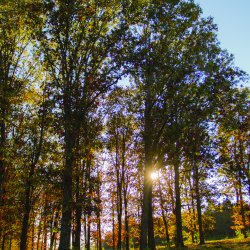Oak, Gambel Deciduous
Quercus gambelii
Gambel oak is a scrubby species native to southern Rocky Mountains and four-corners region of the southwestern US. The oak can vary significantly in size and form from depending on its location.
Oak, Northern Red Deciduous
Quercus rubra
Red oak is Nebraska’s second most abundant native oak occurring on the bluffs of the Missouri River from about South Sioux City to Falls City and extending a few dozen miles westward along some of its major tributaries.
Oak, White Deciduous
Quercus alba
White oak is abundant across much of the eastern US reaching its western limit at about the Missouri River where it just reaches into southeast Nebraska. It's an excellent ornamental tree because of its broad round crown, dense foliage, and purplish-red to violet-purple fall color.
Osage Orange Deciduous
Maclura pomifera
Osage orange was first cultivated in the south in the early 1800s. It was brought north by Professor Jonathan Turner, a biology teacher at Illinois College, and promoted as a living fence by John Wright, editor of The Prairie Farmer
Pawpaw Deciduous
Asimina triloba
Pawpaw is a forest understory tree native to much of the eastern US, reaching its western limit in the oak-hickory forests of southeast Nebraska. It is best known for its large, edible, yellow-green fruits with custard-like pulp. It’s occasionally used as a landscape tree in southeast Nebraska.
Plum, American Deciduous
Prunus americana
American plum is native throughout much of the central US, including the Great Plains. Though typically a shrubby, multi-stemmed plant, it can become a small tree with age reaching up to 20’ tall.
Serviceberry, Downy (Juneberry) Deciduous
Amelanchier arborea
Downy serviceberry is a small forest understory tree native to much of the eastern US and reaching its western limit in southeast Nebraska along the Missouri River. It is occasionally used as a landscape ornamental.
Silver Maple Deciduous
Acer saccharinum
Silver maple was heavily planted as an ornamental in many urban areas because of its ease of transplanting and establishment, adaptability to a wide range of sites, rapid growth, and good form. More recently, the tree has fallen out of favor and new plantings are rare.









